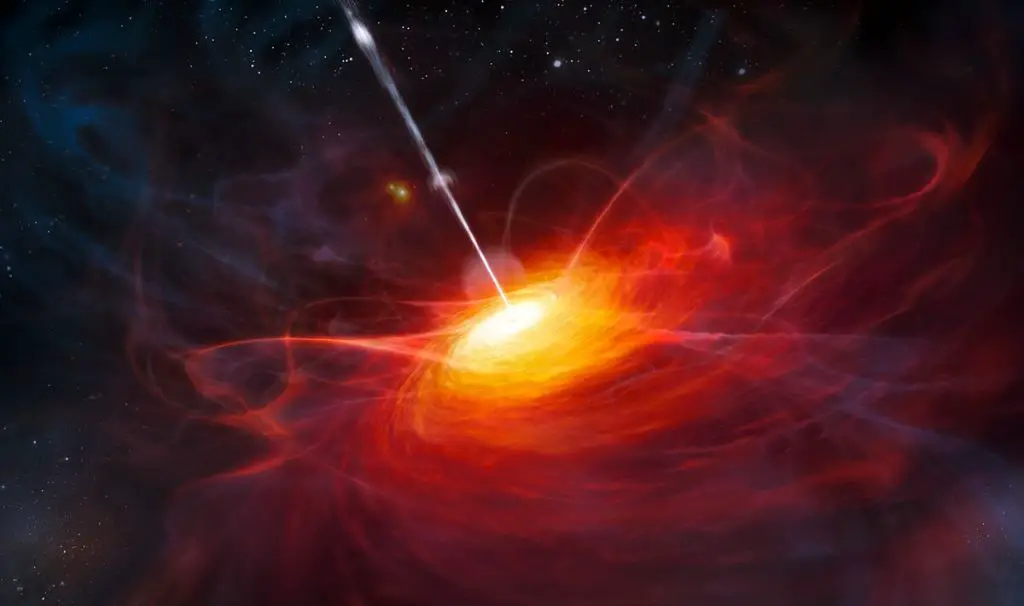Do Quasars Give Off Energy?
What are Quasars?
Quasars are extremely luminous and very distant active galactic nuclei (AGN). Quasars consist of a supermassive black hole surrounded by an accretion disk that spews out material in jets traveling at nearly the speed of light (https://www.legacyias.com/about-the-quasars/). The black hole is estimated to have a mass of 100 million to 1 billion solar masses. The accretion disk around the black hole reaches temperatures of millions of degrees, causing it to emit huge amounts of electromagnetic energy across the spectrum, from radio waves to X-rays.
The term “quasar” is short for quasi-stellar radio source, as quasars were first identified as radio sources in the 1950s. Optical telescopes later revealed them to be star-like points of light, rather than extended sources like galaxies. However, quasars are now known to be extremely distant galaxies with energetic activity fueled by supermassive black holes at their centers.
Some key features of quasars include:
- They are the most luminous objects in the universe, up to 100 times more luminous than a giant elliptical galaxy
- They are very compact – the bright emission comes from a region less than 10 light days across
- They are located at immense distances, with high redshifts indicating they are early galaxies seen when the universe was young
In essence, quasars are believed to represent a brief active phase of galactic evolution, when the growing supermassive black hole at the center accretes matter at a high rate, unleashing copious energy output before gradually quieting down over billions of years.
History of Quasar Discovery
Quasars were first discovered in the 1950s as mysterious radio sources with no visible counterpart. It wasn’t until the 1960s that astronomer Maarten Schmidt recognized the enormous redshift of 3C 273 and realized how incredibly distant and luminous these quasars truly are.
In the 1950s, radio astronomers using very long baseline interferometry began to detect strong radio sources with no discernible optical counterpart. Confused by the nature of these objects, astronomers dubbed them quasi-stellar radio sources, later shortened to “quasars.” Their brightness varied rapidly, ruling out any ordinary star.
In 1963, Maarten Schmidt at Caltech studied the spectrum of 3C 273 and found a tremendous redshift of 0.158, corresponding to a distance around 2 billion light years. This revealed quasars as incredibly luminous objects far beyond our Milky Way galaxy. Their prodigious energy output from such compact regions defied explanation at the time. Schmidt’s discovery showed quasars to be the most distant and luminous objects then known.
References:
EarthSky “What is a quasar?” https://earthsky.org/astronomy-essentials/definition-what-is-a-quasar/
SDSS “SDSS Astronomer Xiaohui Fan is 2003 Newton Lacy Pierce Prize Recipient”
https://classic.sdss.org/news/features/20030121.fan.php
Quasar Energy Source
The primary source of energy for quasars is the supermassive black hole at the center of the active galactic nucleus. The enormous gravity of the black hole causes surrounding gas, dust and even stars to accelerate to tremendous speeds, approaching the speed of light. As this material swirls around in an accretion disk, friction and magnetic fields convert its kinetic energy into intense electromagnetic radiation that is emitted across the spectrum from radio waves to X-rays and gamma rays.
Two main structures around the black hole produce the observed energy output from quasars. The brightly shining accretion disk forms very close to the black hole event horizon and emits thermal electromagnetic radiation corresponding to its high temperatures. Relativistic jets beam out perpendicular to the accretion disk at nearly light speed, emitting synchrotron radiation as particles interact with magnetic fields along the jet. The combination of these emissions accounts for the prodigious energy output of quasars.
Quasar Energy Output
Quasars are among the most energetically powerful objects in the universe. They can emit up to thousands of times more energy than a typical galaxy like our own Milky Way [1]. In fact, quasars are the most luminous objects known, able to outshine their entire host galaxy.
This incredible energy output is produced as matter falls toward the supermassive black hole at the quasar’s center. As material approaches the black hole’s event horizon, immense gravitational forces accelerate the material to tremendous speeds. Viscosity converts kinetic energy to heat, producing energetic radiation across the electromagnetic spectrum, from radio waves to X-rays.

At their peak activity, quasars can briefly exceed the energy production of the rest of the galaxy they reside in [2]. The most energetic quasar outflows ever observed, for example, were estimated to have a total energy output equivalent to two trillion times the power of our sun.
Quasar Emission Mechanisms
Quasars produce enormous amounts of energy, equivalent to hundreds of galaxies. This energy is generated in the region immediately surrounding the supermassive black hole at the center of the quasar. There are several mechanisms that contribute to quasar emissions:
Continuum emission from the accretion disk – Quasars are powered by accretion of material into the supermassive black hole. As material spirals inward, it forms a hot, swirling disk that can heat up to millions of degrees, emitting thermal radiation across the electromagnetic spectrum, from X-rays to infrared.
Broad emission lines from fast-moving gas clouds near the black hole – Gas clouds orbiting close to the black hole emit Doppler broadened emission lines as they move at relativistic speeds. The width of these broad lines allows estimation of the mass of the central black hole.
Narrow emission lines from slower moving clouds further out – Farther from the black hole, lower velocity gas clouds emit narrow emission lines. These lines provide information about the chemical composition and dynamics of the quasar host galaxy.
Non-thermal jet emission – Some quasars have powerful jets streaming out along the poles. These jets emit synchrotron radiation and can extend thousands of lightyears.
Observed Quasar Properties
Quasars have some distinctive observable properties that set them apart from other astronomical objects:
– Very high redshifts indicating great distances. Quasar spectra typically exhibit strong redshift on the order of z = 0.056 to z = 7.085 (according to https://skyserver.sdss.org/dr1/en/proj/advanced/quasars/highz.asp). This implies quasars are incredibly distant objects, with the furthest ones being observed from when the universe was less than a billion years old.
– High luminosities across EM spectrum from radio to X-ray. Quasars emit prodigious amounts of energy, up to 10,000 times more than a typical galaxy like the Milky Way (https://courses.lumenlearning.com/suny-astronomy/chapter/supermassive-black-holes-what-quasars-really-are/). Their power output covers the entire electromagnetic spectrum.
– Rapid variability on timescales of months/years due to activity near black hole. Quasars demonstrate rapid changes in brightness over periods of months to years. This is evidence of a compact emission region, likely associated with gas accretion around a supermassive black hole (https://pubmed.ncbi.nlm.nih.gov/20057613/).
Role of Quasars in Galaxy Evolution
The quasar phase is thought to be most active early in a galaxy’s lifetime, when the supermassive black hole at its center is rapidly accreting matter (Bisogni 2016). The incredible amounts of energy given off by quasars during this phase can actually influence the star formation rate in the surrounding galaxy.
Specifically, the feedback from quasar activity can heat and blow away the gas clouds that would otherwise cool and condense to form new stars (Kotilainen 2021). So quasar feedback is an important mechanism for regulating star formation in galaxies.
Additionally, as matter swirls into the black hole, quasars can drive powerful outflows that spread heavy elements like carbon, oxygen and iron through the galaxy and even into intergalactic space. This quasar-driven enrichment of the intergalactic medium may help seed future generations of galaxies with the basic elements necessary for planet and star formation.
Using Quasars to Study the Distant Universe
Due to their immense luminosity and cosmological distances, quasars can provide a powerful tool for studying the distant universe. One technique involves using quasar absorption lines to probe intergalactic gas between the quasar and Earth (Hall 1996). As the quasar’s light passes through intervening gas clouds, certain wavelengths are selectively absorbed based on the gas composition. Analyzing these absorption lines provides information about the chemical composition and ionization state of gas tens of billions of lightyears away.
In addition, high-redshift quasars located very early in the universe’s history are useful for cosmology studies. Their extreme distances provide a view of the universe’s conditions when it was only a fraction of its current age. Comparing the spectra of these quasars with local ones reveals how physical constants may have changed over cosmic timescales (Hall 1996).
Finally, the fact that quasars are bright point light sources makes them ideal for gravitational lensing observations. Quasar emissions can be magnified and distorted by the gravitational effects of massive objects like galaxy clusters along the line of sight. Studying these gravitational lens systems gives insights into the mass distribution of foreground structures as well as providing a purely gravitational measure of cosmological distances.
Unanswered Questions about Quasars
Despite decades of observations, there are still many open questions about the detailed workings of quasars and their role in galaxy evolution (https://openstax.org/books/astronomy-2e/pages/27-2-supermassive-black-holes-what-quasars-really-are). Some of the major unresolved issues are:
Details of the accretion disk and jet launching – Models of quasar accretion disks involve complex magnetohydrodynamic effects that are not fully understood. More observations are needed to test models of how jets extract energy from the black hole and surrounding accretion disk (https://www1.phys.vt.edu/~jhs/faq/quasars.html).
Relationship between quasars and star formation – There are correlations seen between quasar activity and high rates of star formation in galaxies, but the cause-and-effect relationships are still unclear. Does quasar feedback regulate and shut off star formation, or does abundant gas during mergers fuel both star formation and quasar activity? Disentangling these connections remains an active area of research.
Role of magnetic fields – Magnetic fields likely play a critical role in accretion disk dynamics and jet launching, but observational constraints are still scarce. Improved polarimetric observations and modeling are needed to quantify magnetic field strengths and geometry around quasars.
Overall, many of the detailed microphysics operating within and around quasars are still not fully characterized. More sensitive observations across the electromagnetic spectrum, combined with advanced simulations, will help address these open questions in the coming years.
Conclusion
Quasars are undoubtedly the most energetic objects known in the universe. Their brightness can exceed that of entire galaxies by a factor of one thousand or more. Their prodigious emission of energy comes from matter being accreted at a furious rate onto a central supermassive black hole millions or billions of times the mass of our Sun. As matter spirals into the black hole, immense friction and gravitational forces heat it to billions of degrees, causing it to glow across the electromagnetic spectrum, from radio waves through gamma rays.
Quasars act as beacons illuminating our view of galaxies and intergalactic gas from when the universe was less than a billion years old. The study of quasars provides insights into galaxy evolution, the growth of supermassive black holes, and the cosmic history of star formation. There is still much to be learned about the quasar phenomenon and its role in shaping cosmic structures. But what is certain is that quasars represent some of the most extreme physics found in our universe, giving rise to the most powerful and persistent energy sources known.







